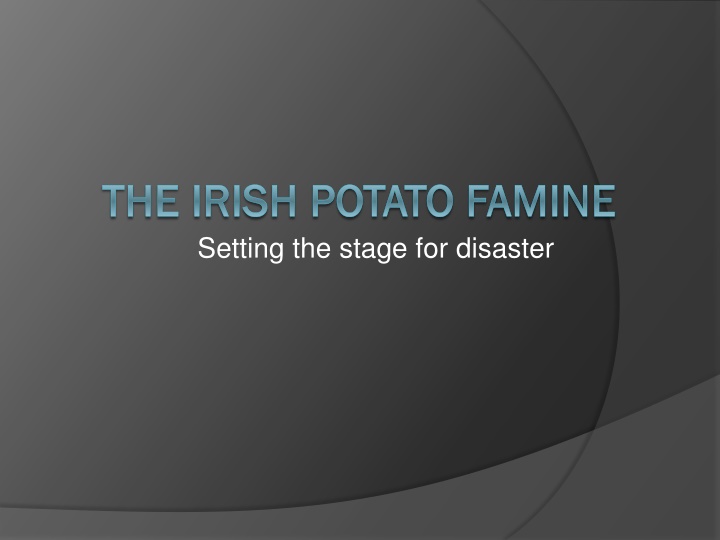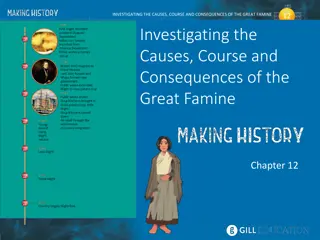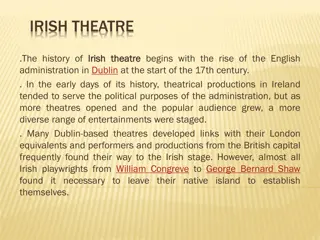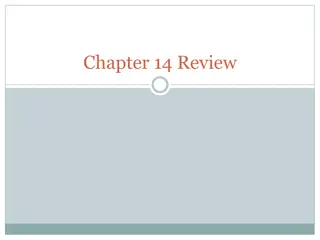The Irish Potato Famine: Setting the Stage for Disaster
The Irish Potato Famine of the mid-19th century was a tragic event that resulted in the deaths of 1 million people and the forced migration of another million in Ireland. The famine was exacerbated by historical injustices, such as British control of Irish lands and discriminatory laws against Catholics. The reliance on potatoes as a staple crop made the population vulnerable to the devastating effects of a potato blight. This event marked a dark period in Irish history, highlighting the complex interplay of socio-economic factors and agricultural reliance that led to widespread suffering and loss.
Download Presentation

Please find below an Image/Link to download the presentation.
The content on the website is provided AS IS for your information and personal use only. It may not be sold, licensed, or shared on other websites without obtaining consent from the author.If you encounter any issues during the download, it is possible that the publisher has removed the file from their server.
You are allowed to download the files provided on this website for personal or commercial use, subject to the condition that they are used lawfully. All files are the property of their respective owners.
The content on the website is provided AS IS for your information and personal use only. It may not be sold, licensed, or shared on other websites without obtaining consent from the author.
E N D
Presentation Transcript
THE IRISH POTATO FAMINE THE IRISH POTATO FAMINE Setting the stage for disaster
Introduction The famine killed 1 million people and forced another 1 million to leave. Most of the land in Ireland was owned by British landlords who rented it to Irish farmers for large amounts of money. One-fourth of the population could read and write. Most farms were 10 acres in size.
Introduction (cont.) 1 acre of land could yield 12 tons of potatoes (feeds a family of 6 for one year). Most Irish farmers lived entirely on the potato. The potato was highly nutritious and actually kept the Irish peasants healthier than the peasants in England who ate only bread.
Before the Famine 1695: Penal laws put in place to punish the Catholics for supporting the Irish King James II (Catholic) over William of Orange (Protestant) 1798: Ireland tried to rebel against English rule, but the rebellion was crushed. Catholics could not vote, hold office, buy land, attend school, possess weapons, or practice their religion. Gaelic language was banned.
Before the Famine (cont.) 80% of Ireland was Catholic. In 1600, Protestants owned 10% of the land. By 1778, Protestants owned 95% of the land because of the Penal Laws. but an entire nation of paupers is what was never seen until it was shown in Ireland. Irish population had reached 8 million. 1838: Poor Law created Workhouses.
Before the Famine (cont.) Workhouses split up the families and put everyone in the family on hard labor, prison- like conditions. 2.4 million Irish (1/4 of the population) were living in complete poverty. Irish begin leaving for North America, where they will assist in massive hard-labor construction projects (hand digging the Erie Canal!) for $1 per day.
The Blight Begins 1845: The leaves on some potato plants blacken and die as the result of an airborne fungus transported in the holds of ships from North America. Fungal spores spread across the United Kingdom in one month, destroying both the leaves and the potatoes underground. Prime Minister Peel moved to repeal the British Corn Law.
The Blight Begins (cont.) The Corn Law kept the price of British Corn very high so that the British Farmers could enjoy the benefits of selling at those prices, but the Irish couldn t afford to buy the corn. Peel s attempt to remove the Corn Law was shot down in British Parliament. Charles Trevelyan (English) takes over the relief effort.
The Blight Begins (cont.) The British continue to IMPORT wheat, barley, oats and oatmeal from Irish farmers. The Irish had to sell the grain for cash to avoid being evicted from their homes even though they needed the food as much as anything. Irish sold off livestock, hoping to get through the year. The crop had never failed two years in a row.
The Blight Begins (cont.) Some Irish borrowed money at high interest from British money-lenders, hoping to stay in their homes and recover the following year. Not only did the potato crop fail the NEXT year as well, it failed for the next three years. Ireland would be nearly ruined.
The Great Hunger June 29, 1846: Prime Minister Peel resigned because of the anger over his attempt to repeal the Corn Laws. Trevelyan takes over full control of the situation. He closes the Corn Meal kitchens which we set up to keep the Irish from starving. He said it was to keep Ireland from being too dependent on England.
The Great Hunger (cont.) The second year of the blight saw it spread 50 miles per week and killed every potato in Ireland. British people who fed the Irish were rebuked for doing the wrong thing. Trevelyan told them that the Irish should form a relief committee. Winter of 1846 was the worst on record. Normally, there is no snow. They got several feet of snow each month through the winter.
The Great Hunger (cont.) Those that died were buried inches beneath the ground. Disease began to spread. Black Fever (spread by lice) and Typhus spread across Ireland. Now food became available for next to nothing, but because there was no money in Ireland, people continued to starve. British landlords began evicting the Irish farmers so that they could grow wheat.
Coffin Ships Landlords began evicting penniless tenants and either sent them to jail or sent them to Canada. The ships were often overcrowded and not well built. The 40 day journey often killed 1 in 5 passengers due to disease and sickness. The line of ships to get into port at Quebec was 2 miles long and took 15 days to process.
Coffin Ships (cont.) Many dead were dumped into the St. Lawrence river and others were piled like wood in mass graves. The landlords promises that there would be someone in Canada to help them were complete lies. They had said anything to get them out of Ireland and onto the ships. 50,000 Irish walked from Canada to America.
Coffin Ships (cont.) If the Irish could not get to North America, they headed for England, hoping to find food. England simply rounded them up and sent them back to Ireland.
Financial Ruin June 8, 1847: British Parliament passed the Irish Poor Law Extension Act which put the entire cost of the famine relief on Ireland s property owners. British Soup kitchens were now being shut down to encourage the Irish to fend for themselves. The British railway industry (unrelated to the potatoes) financially falls apart.
Financial Ruin 11 British banks completely fail. Bankruptcy occurs in hundreds of businesses. This means there will be no money from Britain to help the Irish. Trevelyan passed a law which required any landowner to give up their land in order to receive help. The Irish began to violently rebel against English authority.
Financial Ruin Britain sent 15,000 soldiers to Ireland to reinforce their authority. 1848: Ireland begins to move for Revolution. Britain sends MORE troops. Laws were passed which would send anyone who spoke against the British to jail for 14 years or more. Fall 1848: The potato crop fails for the 3rd time.
Financial Ruin Britain cuts off all help for Ireland. Irish people begin deliberately committing crimes to be sent to the prison colony in Australia were there was food. Thousands of Irish now begin boarding ships and leaving Ireland for America forever.
Gone to America From 1845-1848, nearly 1 million Irish arrived in the USA. Their treatment in the US wasn t much better. Landlords continued to take advantage of the Irish need for housing. Unsanitary conditions led to disease outbreaks. 60% of all children died before the age of 6.
Gone to America (cont.) The Irish now competed with the English-born Bostonians for jobs. The American unions had worked very hard to get wages to $1 per day. The Irish would work for far less than that. By 1850, the Irish made up 43% of the foreign born population in the US. As a result of the mistreatment and the abuse, the Irish kept to themselves.
Gone to America (cont.) This fueled the American stereotypes that Irish were drunks (false) and violent (false). In Boston, Protestant (English ancestry) and Catholic (Irish ancestry) rivalries turned deadly. As the Civil War began, the Irish were drafted into the Federal Army. Following the Civil War, the Irish discovered their way to power was through the Ballot.
Gone to America (cont.) Irish Catholics found their way into government positions and began to change the system to eliminate the unfair practices. One famine descendant (John F. Kennedy) even became president.
After the Famine Back in Ireland, Encumbered Estates Act of 1849 allowed British Landlords to sell off lands of any Irish who was in debt. 1879: The potato blight returned in full force, but this time, the Irish were organized and NO starvation occurred. The Land League (funded by America) organized boycotts against the British landlords.
After the Famine (cont.) The Land War (led by Charles Parnell) led the Irish to fight against the British to keep their lands. 1881: Parnell called off the Land War in exchange for the elimination of all Irish back debt. Wyndham Act 1903: Allowed the Irish to buy back their lands at a low price and pay it back over time to the British government.
After the Famine (cont.) The potato failed all over Europe, but there was no famine except in Ireland. Nature created the potato blight, but the English created the famine. Easter Monday, 1916: Violent clash between Irish and British forces as Ireland moves for independence. Irish Republican Army formed (IRA).
After the Famine (cont.) Bloody Sunday, November 21, 1920: More violence between Irish and British forces. Easter Monday, 1949: 700 years of British rule is ended and Ireland is declared a Republic, free of allegiance to the British Crown. The British, however, retained control of a territory known as Northern Ireland. Violence in Northern Ireland (Irish Protestants and Irish Catholics) played out over decades.
After the Famine (cont.) In summary: 2,500,000 people were lost during the Famine (1/4 of Ireland s population!) 1,000,000 left for other countries. 1,500,000 died. Total British expense for the famine: $7 million. Total Irish expense for the famine: $8.5 million. 40 million Americans have Irish ancestry.























